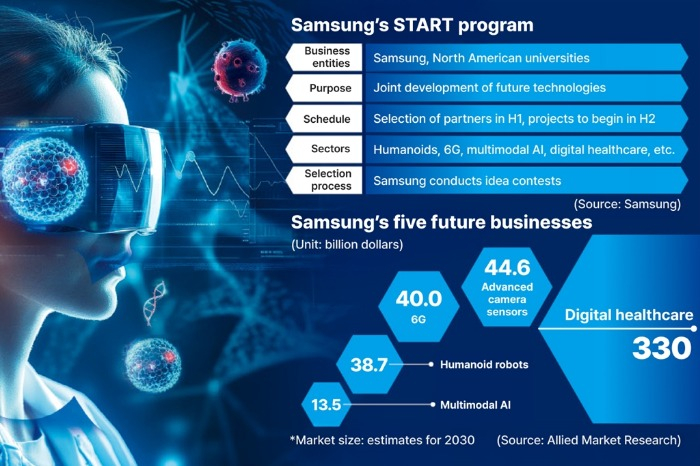
In an ambitious bid to shape the future of technology, Samsung Electronics Co. is launching a sweeping new initiative to collaborate with elite North American universities to delve into growth sectors such as robotics, artificial intelligence and digital healthcare.
The program, dubbed START, short for Strategic Alliance for Research and Technology, represents the South Korean tech giant’s most comprehensive research alliance yet in Silicon Valley and marks a strategic pivot toward deeper open innovation.
Samsung put the START project into action in the first quarter, people familiar with the matter said on Tuesday.
Top technology and engineering universities, including Stanford, Massachusetts Institute of Technology (MIT), California Institute of Technology (Caltech), University of California, Berkeley and University of Toronto, were invited to submit proposals between January and March.
Samsung is currently evaluating presentations from a shortlist of top-tier labs at the universities to choose its partners by the end of June.

Full-scale collaborations will begin in the second half of the year, sources said.
The project is focused on co-developing breakthrough technologies in five business areas: robots, digital healthcare, sixth-generation mobile communications (6G), multimodal AI and next-generation cameras.
These businesses are “promising markets” that not only Samsung but also Big Tech firms sch as Google and Apple are drooling over.
The market size of the five industries is expected to reach $466.8 billion by 2030, according to research firm Allied Market Research.
The START program also opens the door for participating institutions to pitch entirely new areas of exploration to Samsung, one of the sources said.

PIVOT FROM ONE-TO-ONE PARTNERSHIPS
In contrast to Samsung’s historical preference for one-to-one partnerships with individual institutions such as Delhi Technological University (DTU) in India or the University of Texas at Austin for talent acquisition, START uses a competitive open call process.
Each selected lab will receive several million Korean won, or tens of thousands of dollars, in funding per project, sources said.
Twelve projects are being offered in total this year across five focus areas, including emotionally responsive robots and wearable devices capable of detecting asymptomatic diseases in real-time.
“Even a technology powerhouse like Samsung cannot tackle the future alone,” said an executive involved in the initiative. “We’re now aligning ourselves with the best minds in the world to solve fundamental challenges.”
SAMSUNG’S FOCUS PROJECTS
Among the standout projects on which Samsung wants collaboration concerns robotics that aims to build machines capable of reading and interpreting human emotions through facial expressions and gestures, and adjusting their responses accordingly.

Another strand focuses on “coexistence technologies,” such as robots that can assist with dressing or supporting a person based on real-time health feedback – a leap forward in human-robot interaction.
In digital health, Samsung is exploring predictive algorithms that analyze physiological patterns, including heart rate, sleep and respiration, to detect signs of critical conditions like cardiac arrest or chronic illness before symptoms appear.
Smart glasses that use sensors to detect eye movement and breath patterns for early diagnosis are also on the roadmap, sources said.
For AI, Samsung is looking to build multimodal reasoning capabilities –systems that can synthesize and respond to diverse inputs like text, images and speech – something similar to offerings from players like OpenAI.
Enhancing the performance of memory chips to support these services is also a stated goal, according to Samsung.
Other targets include developing ultra-low-power 6G network components and AR-compatible camera sensors, as Samsung races to secure dominance in the next wave of tech platforms.

LEAP-U, LEAP-S
Alongside START, Samsung is also rolling out two open innovation programs: LEAP-U and LEAP-S.
LEAP-U, or leveraging entrepreneurship to accelerate partnerships with universities, focuses on more advanced-stage technologies and includes targeted university partnerships in the US.
LEAP-S seeks to invest in and collaborate with Silicon Valley startups that have already launched products or services.
The two programs are particularly targeting medtech and robotics in particular.
By embedding itself in the early stages of academic and startup innovation, sources said Samsung aims not only to solve hard problems but also to secure first-mover access to future tech leaders.
Analysts view this as a strategic recalibration for Samsung, traditionally more inward-looking in its R&D.
“This is Samsung planting a long-term flag in Silicon Valley,” said an industry executive. “The company is signaling a shift in its business goal from a follower to a trailblazer.”
By Jeong-Soo Hwang and Eui-Myung Park
hjs@hankyung.com
In-Soo Nam edited this article.















